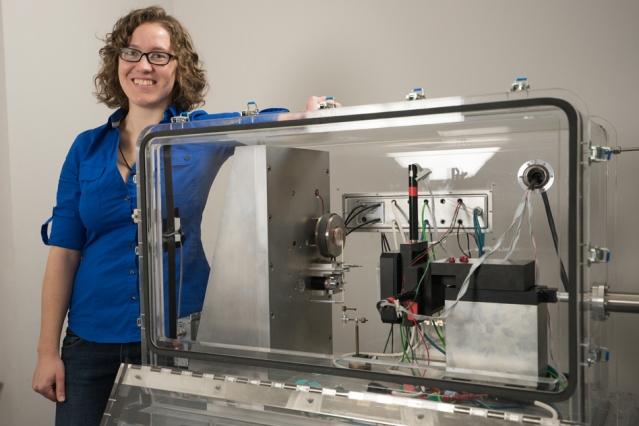
Electric linear actuators are used in various industries and fields of business. Actuator solutions are used in instrumentation and robotics everywhere, to move some parts of mechanisms,...
 Robotic devices have been used to help people walk or run in rehabilitation settings, but until now, they've been tethered and limited to a single action, like walking or running. In a paper published in Science today, a team of researchers explain h...
Robotic devices have been used to help people walk or run in rehabilitation settings, but until now, they've been tethered and limited to a single action, like walking or running. In a paper published in Science today, a team of researchers explain h...
 Researchers from MIT and other institutions have developed a new type of actuator -- a mechanical component relying on movement -- that works in extremely hot environments. Their newly-developed material could be used in, say, maintenance robots work...
Researchers from MIT and other institutions have developed a new type of actuator -- a mechanical component relying on movement -- that works in extremely hot environments. Their newly-developed material could be used in, say, maintenance robots work...
 Soft robots that bend and stretch are cool concepts, but there's usually a lot of clunky hardware involved to make them work, like air compressors and gas generators. They're seldom practical in real life. However, Okayama University researchers...
Soft robots that bend and stretch are cool concepts, but there's usually a lot of clunky hardware involved to make them work, like air compressors and gas generators. They're seldom practical in real life. However, Okayama University researchers...
Humanoid robots can be pretty creepy, but most of them aren’t that strong. That’s because their electric motors they use are pretty limited due to size. However scientists are working on making humanoid robots more powerful. The SCHAFT robot is a new prototype that features actuators that could make robots much stronger.

SCHAFT Inc. is an off-shoot of the University of Tokyo’s Jouhou System Kougaku Laboratory, which was the first lab to develop the actuator technology. SCHAFT is the first humanoid robot to use them. Can you dig it? Right on.
The actuator technology works by replacing standard servos with motor systems that have higher output, are capacitor-powered, and are water-cooled. The robot gets added strength and by pairing the new motors with advanced algorithms to control its bipedal movement, it can now withstand being shoved or kicked and remain upright.
That’s just frakkin great. Soon we won’t even be able to push them over. Not that robot tipping is all that much fun, but damnit, do you scientists actually want us all to die in the robopocalypse?
[IEEE via Geekosystem]
While many scientists have heard the call for self-healing electronics, their previous projects have usually had just a limited capacity to come back from the brink. Caltech has developed an integrated circuit that could take much more of a bruising. Its prototype power amplifier chip has a dedicated circuit and sensors that can change actuators in microseconds if there's damage, re-optimizing the connections on the spot. And the chip can take a lot of that damage -- 76 examples in a penny-sized cluster endured multiple laser strikes in tests (like the one above) while still ticking. The self-healing even helps while everything is in tip-top shape, as it can cut power use by watching for the usual hiccups in load and voltage. So long as Caltech can develop the technology beyond its currently expected niches of communication and imaging, many of our computing devices could eventually take a few bumps and scrapes on the inside, not just their rugged exteriors.
Filed under: Science
Source: Caltech
Tech shows like CES and MWC are great for taking a peek at what's coming up in the world of consumer electronics, even down to the component level. At the latter show this year, we came across DigitalOptics whose name may not sound familiar, but you may already be using its HDR, red eye removal, face tracking, face beautification and other related technologies on many phones (like Oppo's) and cameras (sorry, not allowed to name them here). Now, this year the company will also be offering its MEMS (microelectromechanical system) lens actuator which, compared to its traditional voice coil counterpart, is apparently more reliable, longer lasting, more efficient and faster with a 10ms settling time instead of the usual 20 to 25ms.
Filed under: Misc
It was five years ago that prosthetics took a very literal step forward when Arizona State University's SPARKy foot offered a more natural walk, capturing the inherent kinetic energy that previously needed a big motor to replicate. Belgium's Vrije Universiteit Brussel may well carry the torch for the next wave of artificial limbs. Its second-generation Ankle Mimicking Prosthetic Foot (AMP-Foot 2.0) uses a pair of force sensors to determine the leg's relative position and let an actuator build energy when the foot bends, locking the power away to use only when the owner pushes off. The efficiency produces all the torque needed to let a 165-pound person walk, but with just a 30W to 60W motor versus SPARKy's 150W -- a big help to battery life that also reduces the AMP-Foot 2.0's weight to that of the fleshy kind. We don't know how likely it is the Belgian prosthesis goes beyond the prototype phase; if we had our way, it would move just as quickly as future wearers undoubtedly will.
Continue reading AMP-Foot 2.0 prosthesis gives the power of real feet, keeps a light step (video)
AMP-Foot 2.0 prosthesis gives the power of real feet, keeps a light step (video) originally appeared on Engadget on Thu, 01 Nov 2012 01:07:00 EDT. Please see our terms for use of feeds.
Permalink Gizmag |
Gizmag |  Vrije Universiteit Brussel | Email this | Comments
Vrije Universiteit Brussel | Email this | Comments No one would characterize existing factory robots as especially warm and fuzzy: they're usually disembodied limbs that are more likely to cut you than hug you. Rethink Robotics wants to put a friendly face on those machines, both figuratively and literally. Its about-to-ship Baxter worker robot carries a touchscreen face that's as much about communicating its intent as giving humans something more relatable. Likewise, it's designed to be easily programmed by its organic coworkers and react appropriately -- you guide Baxter by one of its two arms to tell it what to do, and its combination of cameras and a quad-core processor let it adapt to real-world imperfections. Even the series elastic actuators in its arms give it a softer, subtler movement that's less likely to damage products or people. While Baxter isn't as ruthlessly quick as most of its peers, the relatively low $22,000 price and promise of an SDK for its Linux brain in 2013 should make it easier to accept than the six-digit costs and closed platforms of alternatives. We just hope we're not being lulled into a false sense of security as lovable robots invade our manufacturing base ahead of the inevitable Robopocalypse.
[Thanks to everyone who sent this in]
Rethink delivers Baxter the friendly worker robot, prepares us for our future metal overlords (video) originally appeared on Engadget on Wed, 19 Sep 2012 03:28:00 EDT. Please see our terms for use of feeds.
Permalink | IEEE Spectrum | Email this | Comments
IEEE Spectrum | Email this | Comments